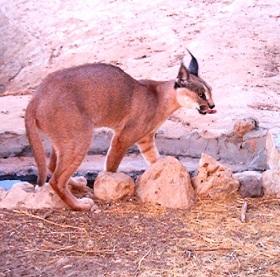Using AI to control energy for indoor agriculture
30 September 2024
Published online 5 July 2012

Conservation efforts are underway to ensure the survival of a rare wild cat captured on camera in Jordan's Dana Biosphere Reserve. The caracal was last spotted in Jordan in 1995 and the species was thought to have disappeared.
Cameras were installed in the reserve in 2008 to help researchers learn more about its wildlife. Analysis of footage recorded during the past year suggests there are five adult caracals living in the reserve.
Since the last sighting on the Dana reserve in 1995 - when a male caracal was caught in a trap during a survey of carnivorous species – there had only been anecdotal reports of its existence. Ehab Eid, field research coordinator at the Royal Society for the Conservation of Nature (RSCN) in Jordan said information about the Caracal caracal was sketchy. "We only had some reports from rangers in Dana who said they saw it. No photos were ever taken nor did we have estimates for its population size," he says.
While the caracal is common in Africa, it is a rare species in Jordan, according to Eid. "The recent footage confirms its presence, provides us with a wide range of pictures and gives us some indications about its niche." Caracals are medium-sized, territorial, nocturnal hunters. All the pictures taken so far of them in the reserve have been of single specimens and researchers have not seen any interaction between the adults.
"The caracal is very secretive and able to exist without detection. The population is likely to be much larger than the five found so far," says Sherif Baha El Din, an environmental consultant and chairman of the board of Nature Conservation Egypt, a non-governmental organization dedicated to the conservation of Egypt's natural heritage. "Areas that are known to be of importance for these animals should be protected and kept out of heavy public use."
The lack of any kittens in the footage is of concern to Eid. "We are running a second year research programme where we have expanded our research areas." If cameras fail to confirm the caracals are breeding, then RSCN will discuss breeding them in captivity and reintroducing them later.
Baha El Din, however, disagrees with the proposal to breed in captivity. "It is best to leave them in the wild. It is better to provide them with protection from hunting and ensure that their basic ecological needs are met. For example, ensure that prey is available and that their entire home range is secured from potential adverse impacts.
"The idea is maintain wild animals as functioning components of the ecosystem and not just keep the species as individuals in a zoo. Collecting the animals into a zoo would mean that the species is extinct."
Eid stresses they are trying to create a safe environment for the newly-discovered caracals. "Our ecotourism facilities are restricted to areas far away from the caracal niche and our night trapping cameras confirm that the caracals avoid areas where human are present." Zoning and patrolling schemes are a core component of the reserve management plan.
Outside the Dana reserve, there have been a few reports of caracal sightings in different localities. The latest report was in the eastern desert in Jordan, but extensive surveying in 2010 failed to confirm this.
Across the Middle East and North Africa, there is great disparity in the research done on the status of species. Jordanian conservationists have begun work on a Red List to document the kingdom's mammals. According to Baha El Din, Egypt has an incomplete national Red List. "There are certainly large areas in places such as Libya and Yemen where very little is known of the status of some localised species. In Yemen, many species are not yet described let alone evaluated on the Red List."
doi:10.1038/nmiddleeast.2012.95
Stay connected: